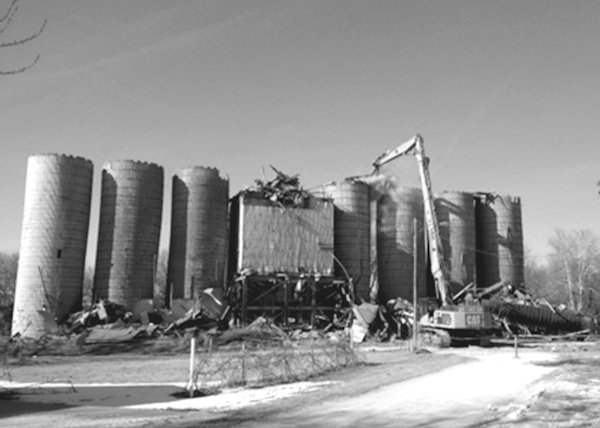
The Hancock-Henderson Quill, Inc.
by Dessa Rodeffer, Quill Publisher-Owner
Another part of Lomax's rich history has disappeared this past week as an excavating crew took down what had been an icon in the village since the early 1900s-"The Lomax Elevator".
The elevator's first structure, the wooden elevator, was built at the beginning of the town's history in 1912, along the Atckinson-Topeka-Sante Fe Railroad.
According to Beryl Sparrow, local historian, the building passed through several ownerships and was last purchased in the 1980s by Stronghurst Grain & Mdse..
Stronghurst Grain & Mdse. board member Brad Flatt, of Media, said the facility they had purchased over thirty years ago had become inefficient and the elevator scales were too small to allow for the larger semi's of today so it was decided to turn the ground back over to its owners, ending 103 year tradition of grain elevator service in Lomax.
The Lomax Elevator had expanded to 7 tall cement silos and a large wooden elevator, scales, and office that was demolished on Thursday, Friday, and Saturday morning, according to Flatt.
Flatt said that although the facility is owned by Stronghurst Grain & Mdse., the property that it stood on next to BNSF railroad is owned by the railroad and has been leased on a yearly basis.
Another long flat storage building is at question to who owns the property that it is on and is yet to be determined through court records and documentations. At this point the railroad records and the county courthouse records have different viewpoints.
Stronghurst Grain sought after bidders and hired the lowest bidder, LEE Farms Excavating in Onarga, IL,founded in 1979. According to their website, they service all of the continental United States, specializing in Demolition and Excavating from large buildng projects to removing garage floors, with a mission statement to eliminate waste through the use of current technology, reduce footprint by recycling recovered material, and to keep all work sites clean and safe.
To turn the land back to the railroad, Stronghurst Grain must demolish the buildings, clean up the property, and pass an inspection by BNSF railroad officials.
Trains are constantly passing by, and railroad officials were watching during the project, making sure no debri landed on the tracks. LEES' workers, stopped each time a train went by and then continued with its demolition once the train was out of sight.
Flatt said that LEES' brought three large Hydraulic Excavators but most of the time, two were running, and BNSF had one to five railroad employees at all times.
"It seemed like only a few minutes to take a silo down and an hour to take down the wooden structure," he said. "Besides the demo work, a man came from Muscatine and sorted the wood from the steel. They are very experienced," he said, "and have plans to haul away, scrap, and sell whatever they can."
Flatt didn't think there were any incidents of debri on the railroad tracks. "Everything went pretty smoothly. Their equipment was moved in early in the week and then, the office and scales were torn off first, he said.
Flatt said Stronghurst Grain & Mdse operated the facility up until two or three years ago. They are not planning on building in Lomax, but are discussing adding a more up-to-date storage in Stronghurst, similar to the last expansion.
The landscape straight north of "The Pink" has changed, but many historians like Beryl Sparrow, will keep etched in their minds, The Lomax Elevator, along with the many other businesses that had once lined the tracks of the Atchison, Topeka and Santa Fe Railway, such as the stockyard, an oil business, a coal business, the depot, and will continue to keep their stories alive for future generations.

Richard Gooden in one of three huge CAT excavating machines that came to demolish The Lomax Elevator last week.
-photo by Dan Gillett